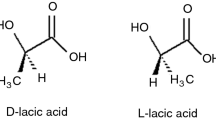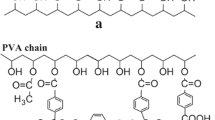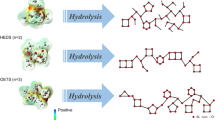Abstract
Alkyl-modified phenylsilsesquioxane (PhSSQ) particles were prepared from phenyltriethoxysilane by two-step acid-base catalysed sol–gel process, using alkyltriethoxysilanes of varying chain length (methyl, ethyl, pentyl and octyl), in order to control the softening temperature and thermal stability of the resulting particles. Resulting particles were characterized by scanning electron microscopy, X-ray diffraction analysis, gel permeation chromatography and Fourier-transform infrared spectroscopy, while the thermal properties were investigated by differential scanning calorimetry and thermogravimetric analysis. Increased chain length presents steric hindrance to condensation of phenyltriethoxysilane, leading to decreased softening temperature and thermal stability, while copolymerization with methyltrialkoxysilane leads to increase of softening temperature without influencing the thermal stability. Copolymerization with alkyltrialkoxysilanes is therefore a feasible method to control the softening temperature of PhSSQ particles. By their properties the modified PhSSQ could be grouped in short-chain modified (methyl and ethyl) and long-chain modified (pentyl and octyl) ones.







Similar content being viewed by others
References
Wight AP, Davis ME (2002) Design and preparation of organic-inorganic hybrid catalysts. Chem Rev 102:3589–3614
Sanchez C, Lebeau B, Chaput F, Boilot J-P (2003) Optical properties of functional hybrid organic-inorganic nanocomposites. Adv Mater 15:1969–1994
Voronkov MG, Lavrentyev VI (1982) Polyhedral oligosilsesquioxanes and their homo derivatives. In: Boschke FL (ed) Inorganic ring systems, topics in current chemistry series, vol 102. Springer, Berlin, pp 199–236
Baney RH, Itoh M, Sakakibara A, Suzuki T (1995) Silsesquioxanes. Chem Rev 95:1409–1430
Loy DA, Baugher BM, Baugher CR, Schneider DA, Rahimian K (2000) Substituent effects on the sol–gel chemistry of organotrialkoxysilanes. Chem Mater 12:3624–3632
Arkhireeva A, Hay JN, Oware W (2005) A versatile route to silsesquioxane nanoparticles from organically modified silane precursors. J Non-Cryst Solids 351:1688–1695
Choi JY, Kim CH, Kim DK (1998) Formation and characterization of monodisperse, spherical organo-silica powders from organo-alkoxysilane-water system. J Am Ceram Soc 81:1184–1188
Matsuda A, Tanaka T, Tadanaga K, Minami T, Tatsumisago M (2004) Preparation and characterization of copolymerized methylsilsesquioxane-benzylsilsesquioxane microparticles for electrophoretic sol–gel deposition. J Mater Sci 39:903–909
Shibata S, Yamane M, Kamada K, Ohta K, Sasaki K, Masuhara H (1997) Laser emission from dye-doped organic-inorganic particles of microcavity structure. J Sol-Gel Sci Technol 8:959–964
Hah HJ, Kim JS, Jeon BJ, Koo SM, Lee YE (2003) Simple preparation of monodisperse hollow silica particles without using templates. Chem Commun 171:2–1713
Matsuda A, Sasaki T, Hasegawa K, Tatsumisago M, Minami T (2000) Thermal softening behavior of poly(phenylsilsesquioxane)and poly(benzylsilsesquioxane) particles. J Ceram Soc Jpn 108:830–835
Matsuda A, Sasaki T, Hasegawa K, Tatsumisago M, Minami T (2001) Thermal softening behavior and application to transparent thick films of poly(benzylsilsesquioxane) particles prepared by the sol–gel process. J Am Ceram Soc 84:775–780
Takahashi K, Tadanaga K, Hayashi A, Matsuda A, Tatsumisago M (2006) Formation of convex shaped poly(phenylsilsesquioxane) micropatterns on indium tin oxide substrates with hydrophobic-hydrophilic patterns using the electrophoretic sol–gel deposition method. J Mater Res 21:1255–1260
Daiko Y, Katagiri K, Ogura K, Sakai M, Matsuda A (2007) Preparation and characterization of surface-sulfonated phenylsilsesquioxane–methylsilsesquioxane particles. Solid State Ionics 178:601–605
Daiko Y, Ogura K, Katagiri K, Muto H, Sakai M, Matsuda A (2008) Surface-sulfonation and fuel cell properties of phenylsilsesquioxane-based particles. Solid State Ionics 179:1166–1169
Takahashi K, Tadanaga K, Matsuda A, Hayashi A, Tatsumisago M (2007) Thermoplastic and thermosetting properties of polyphenylsilsesquioxane particles prepared by two-step acid-base catalyzed sol–gel process. J Sol-Gel Sci Technol 41:217–222
Jitianu A, Amatucci G, Klein LC (2009) Phenyl-substituted siloxane hybrid gels that soften below 140 °C. J Am Ceram Soc 92:36–40
Takahashi K, Tadanaga K, Hayashi A, Tatsumisago M (to be submitted) Substituent effects on the glass transition phenomena of polyorganosilsesquioxane particles prepared by two-step acid-base catalyzed sol–gel process
Prado LASA, Radovanovic E, Pastore HO, Yoshida IVP, Torriani IL (2000) Poly(phenylsilsesquioxane)s: structural and morphological characterization. J Polym Sci A Polym Chem 38:1580–1589
Liu S, Lang X, Ye H, Zhang S, Zhao J (2005) Preparation and characterization of copolymerized aminopropyl/phenylsilsesquioxane microparticles. Eur Polym J 41:996–1001
Acknowledgments
This work was partially supported by a Grant-in-aid from the Ministry of Education, Culture, Sports, Science and Technology of Japan. J.M. visited Japan as a research fellow of The Matsumae International Foundation, and is grateful for their support.
Author information
Authors and Affiliations
Corresponding author
Rights and permissions
About this article
Cite this article
Macan, J., Tadanaga, K. & Tatsumisago, M. Influence of copolymerization with alkyltrialkoxysilanes on condensation and thermal behaviour of poly(phenylsilsesquioxane) particles. J Sol-Gel Sci Technol 53, 31–37 (2010). https://doi.org/10.1007/s10971-009-2051-x
Received:
Accepted:
Published:
Issue Date:
DOI: https://doi.org/10.1007/s10971-009-2051-x




